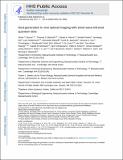Next-generation in vivo optical imaging with short-wave infrared quantum dots
Author(s)
Riedemann, Lars; Bartelt, Alexander; Jaworski, Frank B.; Kloepper, Jonas; Heeren, Joerg; So, Peter T. C.; Fukumura, Dai; Jain, Rakesh K.; Bruns, Oliver Thomas; Bischof, Thomas Stanley; Harris, Daniel Kelly; Franke, Daniel; Shi, Yanxiang; Carr, Jessica Ann; Rowlands, Christopher; Wilson, Mark William Brennan; Chen, Ou; Wei, He; Hwang, Gyuweon; Montana Fernandez, Daniel M; Coropceanu, Igor; Achorn, Odin Brautigam; Jensen, Klavs F; Bawendi, Moungi G; ... Show more Show less
Downloadnihms857158.pdf (3.236Mb)
PUBLISHER_POLICY
Publisher Policy
Article is made available in accordance with the publisher's policy and may be subject to US copyright law. Please refer to the publisher's site for terms of use.
Terms of use
Metadata
Show full item recordAbstract
For in vivo imaging, the short-wavelength infrared region (SWIR; 1,000-2,000 nm) provides several advantages over the visible and near-infrared regions: general lack of autofluorescence, low light absorption by blood and tissue, and reduced scattering. However, the lack of versatile and functional SWIR emitters has prevented the general adoption of SWIR imaging by the biomedical research community. Here, we introduce a class of high-quality SWIR-emissive indium-arsenide-based quantum dots that are readily modifiable for various functional imaging applications, and that exhibit narrow and size-tunable emission and a dramatically higher emission quantum yield than previously described SWIR probes. To demonstrate the unprecedented combination of deep penetration, high spatial resolution, multicolour imaging and fast acquisition speed afforded by the SWIR quantum dots, we quantified, in mice, the metabolic turnover rates of lipoproteins in several organs simultaneously and in real time as well as heartbeat and breathing rates in awake and unrestrained animals, and generated detailed three-dimensional quantitative flow maps of the mouse brain vasculature.
Date issued
2017-04Department
Massachusetts Institute of Technology. Department of Biological Engineering; Massachusetts Institute of Technology. Department of Chemical Engineering; Massachusetts Institute of Technology. Department of Chemistry; Massachusetts Institute of Technology. Department of Materials Science and EngineeringJournal
Nature Biomedical Engineering
Publisher
Nature Publishing Group
Citation
Bruns, Oliver T. et al. “Next-Generation in Vivo Optical Imaging with Short-Wave Infrared Quantum Dots.” Nature Biomedical Engineering 1, 4 (April 2017): 0056 © 2017 Macmillan Publishers Limited, part of Springer Nature
Version: Author's final manuscript
ISSN
2157-846X